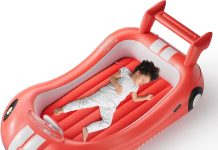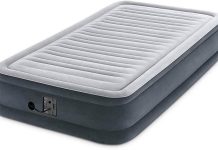Have you ever wondered how to effectively clean mold and mildew from your air mattress? It’s a common issue that many people face, but fear not! In this article, we will share some simple yet effective techniques that will help you rid your air mattress of these unwanted guests. Say goodbye to the musty smell and potential health risks – let’s get your air mattress looking and feeling fresh again!
Review contents
Prevention
Keeping your air mattress clean and free from mold and mildew is the key to maintaining its longevity and ensuring a healthy sleeping environment. By following these simple prevention tips, you can avoid the hassle of dealing with mold and mildew altogether.
Regular cleaning and maintenance
The first step in preventing mold and mildew growth is regular cleaning and maintenance. After using the air mattress, take some time to carefully clean it before storing it away. Use a mild soap or detergent and warm water to gently scrub the surface of the mattress. Pay special attention to any visible stains or areas that may have come into contact with moisture.
Proper storage
Properly storing your air mattress is crucial in preventing mold and mildew. Make sure the mattress is completely dry before packing it away. Moisture is a breeding ground for mold and mildew, so it’s important to remove any excess moisture before storing it. Additionally, store the mattress in a dry, well-ventilated area to further prevent the growth of mold and mildew.
Using a mattress protector
Another effective measure to prevent mold and mildew is to use a mattress protector. These protective covers act as a barrier between your body and the mattress, preventing sweat, spills, and other liquids from seeping into the mattress. Look for a waterproof and breathable mattress protector that fits snugly over your air mattress. This will not only protect against mold and mildew but also extend the lifespan of your mattress.
Identifying Mold and Mildew
Before you can start cleaning your air mattress, it’s important to identify if mold and mildew are present. There are two key indicators to look out for.
Visible signs
The most obvious indication of mold and mildew growth is the presence of visible stains or discoloration on the surface of the mattress. These stains may appear green, black, or even grayish in color. Mold and mildew can also give the mattress a fuzzy or slimy texture. If you notice any of these signs, it’s time to take action and clean your mattress thoroughly.
Unpleasant odor
Another way to identify mold and mildew is by the musty and unpleasant odor they emit. Mold and mildew have a distinct smell that is often described as dank or earthy. If you detect this odor coming from your air mattress, it’s a clear indication of mold and mildew growth. Don’t ignore it, as mold and mildew can cause respiratory issues and other health problems if left unchecked.
Removing Mold and Mildew from the Surface
If your air mattress has visible mold and mildew stains, it’s important to act fast to prevent further growth and damage. Cleaning the surface is the first step in tackling the issue.
Gather supplies
Before you begin cleaning, gather the necessary supplies. You will need a mild detergent, warm water, a soft brush or cloth, and a bucket. Ensure that the cleaning tools you select are appropriate for use on your air mattress to avoid any potential damage.
Create a cleaning solution
In the bucket, mix a small amount of mild detergent with warm water. Be careful not to use too much detergent, as it can leave behind a residue on the mattress. Aim for a gentle solution that will effectively break down the mold and mildew without harming the mattress material.
Scrub the affected area
Dip the soft brush or cloth into the cleaning solution and gently scrub the affected area. Use circular motions to loosen the mold and mildew stains from the surface of the mattress. Be thorough but gentle to avoid damaging the material.
Rinse and dry the mattress
Once you have successfully removed the mold and mildew stains, rinse the mattress thoroughly with clean water. Ensure that all traces of the cleaning solution are removed. After rinsing, it’s essential to let the mattress dry completely before using or storing it. Place it in a well-ventilated area and allow it to air dry naturally. Avoid using a hairdryer or applying direct heat, as it can damage the mattress.
Treating Deeply Embedded Mold and Mildew
In some cases, mold and mildew may have penetrated deeper into the material of your air mattress. To effectively treat and eliminate these deeply embedded mold and mildew spots, follow these steps.
Prepare the mattress
Before treating the deeply embedded mold and mildew, remove all bedding and any other items from the mattress. This will allow you to work on the affected areas more effectively.
Apply a mold and mildew remover
There are various commercial mold and mildew removers available on the market. Choose one that is specifically formulated for use on fabrics or mattresses. Follow the instructions provided by the manufacturer to apply the remover to the affected areas. Be generous but not excessive, as too much product can damage the mattress.
Allow the solution to work
Once the remover is applied, allow it to penetrate the mold and mildew spots. Follow the manufacturer’s recommended wait time for optimal results. During this time, keep the area well-ventilated to prevent the buildup of fumes.
Scrub the mattress
After the recommended wait time has passed, use a soft brush or cloth to gently scrub the mold and mildew spots. Apply moderate pressure to ensure thorough cleaning without causing damage to the material. Continue scrubbing until the mold and mildew stains are no longer visible.
Rinse and dry the mattress
After successfully removing the deep-seated mold and mildew, rinse the mattress with clean water to remove any residual remover. Thoroughly rinse to ensure all traces of the solution are gone. Once rinsed, follow the same drying process as mentioned earlier to ensure the mattress is completely dry before use or storage.
Using Natural Remedies
If you prefer natural alternatives to commercial cleaners, there are a few household items that can effectively combat mold and mildew.
Vinegar
Vinegar is a versatile and natural cleaning agent that can help kill mold and mildew. Dilute white vinegar with water in a 1:1 ratio and apply it to the affected areas using a spray bottle or cloth. Let it sit for a few minutes, then scrub the stains with a soft brush. Rinse thoroughly and dry the mattress as usual.
Baking soda
Baking soda is known for its odor-absorbing properties and can help eliminate musty smells caused by mold and mildew. Sprinkle baking soda generously over the affected areas and let it sit for a few hours or overnight. Vacuum the mattress to remove the baking soda residue and any remaining mold or mildew particles.
Tea tree oil
Tea tree oil is a natural antifungal and antibacterial agent that can effectively kill mold and mildew spores. Mix a few drops of tea tree oil with water in a spray bottle and spritz it onto the affected areas. Let it sit for a few hours before gently scrubbing the stains. Rinse well and dry the mattress thoroughly.
Cleaning the Air Pump and Valve
While you focus on cleaning the surface of your air mattress, it’s equally important to clean the air pump and valve to maintain proper functionality and prevent the growth of mold and mildew.
Disconnect the pump
Unplug the air pump from the mattress and remove any attachments or accessories. This will make it easier to clean and prevent any damage to the electrical components.
Wipe down the exterior
Use a damp cloth or disinfectant wipe to clean the exterior of the air pump. Pay attention to any crevices or hard-to-reach areas where dust and debris can accumulate. Ensure that the pump is completely dry before reattaching it to the mattress.
Cleaning the valve
The valve is a critical component of your air mattress, as it controls the inflation and deflation process. Use a soft brush or cloth to gently clean the valve, removing any dirt or debris that may have accumulated. Be careful not to damage the valve or force it in any way. Once cleaned, allow the valve to dry before reassembling.
Drying the Mattress Properly
Properly drying your air mattress after cleaning is essential to prevent the growth of mold and mildew and maintain its overall hygiene.
Remove excess moisture
Before drying, remove any excess moisture from the mattress. Use a clean, dry towel to blot and absorb as much moisture as possible. Avoid pressing too hard, as this can push moisture deeper into the material.
Air-dry in sunlight
The sun is a natural and effective way to dry your air mattress. Find a sunny spot in your yard or a well-ventilated area and lay the mattress flat. Allow it to absorb the warmth of the sun and air dry naturally. Flip the mattress periodically to ensure both sides are thoroughly dried.
Use a fan or dehumidifier
If sunlight is not an option or for faster drying, you can use a fan or a dehumidifier to aid the drying process. Position a fan near the mattress to promote air circulation and speed up drying time. Alternatively, a dehumidifier can help remove excess moisture from the surrounding air, assisting in the drying process.
Preventing Mold and Mildew Growth in the Future
Taking preventive measures is key to maintaining a mold and mildew-free air mattress. Incorporate these practices into your routine to keep your mattress clean and safe.
Regularly clean and dry the mattress
Make it a habit to clean your air mattress regularly. After each use, wipe down the surface with a clean cloth to remove any sweat or spills. By staying on top of the cleanliness, you can prevent the buildup of moisture and reduce the risk of mold and mildew growth.
Store in a well-ventilated area
When not in use, store your air mattress in a dry and well-ventilated area. Avoid storing it in a damp basement or an area prone to moisture. Opt for a closet or an elevated space where air can circulate freely.
Use moisture-absorbing products
To further prevent mold and mildew growth, consider using moisture-absorbing products, such as silica gel packs or moisture-absorbing crystals. Place them near or inside the storage bag or container to absorb excess moisture and maintain a dry environment.
Consider using a dehumidifier
If you live in a humid climate or your home has high humidity levels, consider investing in a dehumidifier. Regulating the humidity indoors can significantly reduce the chances of mold and mildew growth, not just on your air mattress but throughout your living space.
When to Replace an Air Mattress
In some cases, the mold and mildew damage on your air mattress may be too extensive to salvage. Knowing when to replace your mattress is vital for your health and well-being.
Extensive mold and mildew damage
If the mold and mildew damage on your air mattress is widespread and deeply embedded, it may be impossible to fully restore it to a safe and hygienic condition. In such cases, it’s best to discard the mattress and invest in a new one.
Persistent odor
Even after thorough cleaning, if your air mattress continues to emit a musty or unpleasant odor, it may be a sign of persistent mold and mildew growth. Persistent odor indicates that the spores have likely spread throughout the mattress, making it difficult to fully eliminate the problem. It’s advisable to replace the mattress in such situations.
Deterioration of material or structure
If your air mattress shows signs of deterioration, such as tears, punctures, or a compromised structure, it may be time to replace it. Mold and mildew can weaken the material and compromise the integrity of the mattress, making it less effective and potentially unsafe to use.
Conclusion
Cleaning mold and mildew from an air mattress is an important task to ensure its hygiene, longevity, and your overall health. By following the preventive measures outlined in this article and taking prompt action when mold and mildew are detected, you can maintain a clean and safe sleeping surface. Remember to clean the mattress regularly, keep it dry and well-ventilated, and store it properly to minimize the risk of mold and mildew growth. When in doubt, always prioritize your health and replace your air mattress if necessary. With proper care, your air mattress will provide you with a comfortable and healthy sleeping experience for years to come.































